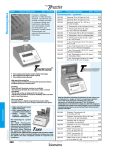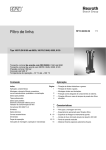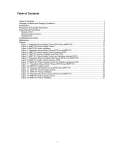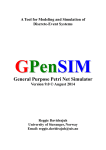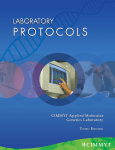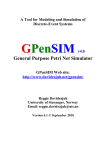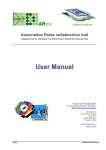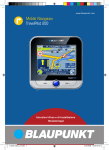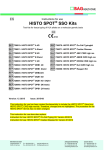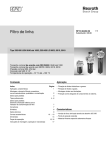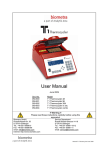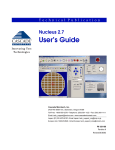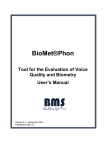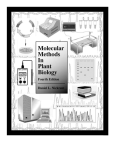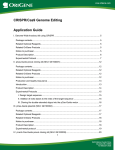Download TissueScan Disease Tissue qPCR Arrays - cDNA panels
Transcript
Tissue qPCR Arrays cDNA Panels for Disease Gene Expression Profiling Application Guide Table of Contents Package Contents and Storage Conditions ................................................................. 2 Introduction.................................................................................................................. 3 Production and Quality Assurance:.............................................................................. 3 Experimental Procedures ............................................................................................ 5 Real-Time Protocol .................................................................................................. 5 Regular PCR Protocol.............................................................................................. 7 Trouble-shooting Guide ............................................................................................... 8 No PCR product detected ........................................................................................ 8 More than one PCR product detected on an agarose gel ........................................ 8 Detection of both specific band(s) and a background smear ................................... 9 Frequently Asked Questions........................................................................................ 9 Compatible thermocyclers............................................................................................. 10 References ................................................................................................................ 11 Revised 02.02.09TS 1 Package Contents and Storage Conditions The following components are included: • Identical, sealed Tissue qPCR Array plates containing dried, PCR*-ready, first-strand cDNAs (partial list below, full listing at http://www.origene.com/geneexpression/ ) • Adhesive cover sheets for sealing the multi-well, real-time PCR plates • Control primers: human beta-actin@1 nm/200uL (use 2uL per reaction). TissueScanTM Tissue qPCR Arrays Format (Wells) Human Colon Cancer I - IV 48 (4x12) Human Lung Cancer I – IV 48 (4x12) Human Lung Cancer I 48 (4x12) Human Ovarian Cancer I - II 48 (4x12) Human Prostate Cancer I – II 48 (4x12) Human Prostate Cancer I 48 (4x12) Human Breast Cancer I - IV 48 (4x12) Human Lymphoma I – II 48 (4x12) Human Kidney Cancer I - II 48 (4x12) Human Gastroesophageal I - II 48 (4x12) Human Crohn’s & Colitis I - II 48 (4x12) A full listing of all available panels (more added monthly), please go to http://www.origene.com/geneexpression/ Control primers Human ß-actin Human ß-actin Human ß-actin Human ß-actin Human ß-actin Human ß-actin Human ß-actin Human ß-actin Human ß-actin Human ß-actin Human ß-actin The above components are shipped at room temperature, but should be kept at -20°C for long-term storage. If properly stored, they have a 12-month shelf life. OriGene and Cytomyx have joined forces to provide you with the following TissueScan Tissue qPCR Arrays as well as all corresponding materials from each sample such as Tissues, DNA, RNA and Protein. The following components are required but are not provided: • • • Reagents for real-time PCR amplification (2X master mix) Gene-specific primers and probe or SYBR Green I dye A 96-well real-time thermocycler (384- real time thermocycler in the case of the 384 Cancer Survey Panels * The polymerase chain reaction (PCR) is protected by patents held by Hoffmann-La Roche. Purchase of any of OriGene’s PCR-related products does not convey a license to use the PCR process, covered by these patents. Purchasers of these products must obtain a license before performing PCR. NOTE: FOR RESEARCH PURPOSES ONLY. NOT FOR DIAGNOSTIC OR THERAPEUTIC USAGE. -2- Introduction Gene expression profiling is one of the most frequently used approaches for characterizing novel transcripts either derived from expressed sequence tag (EST) projects or the completed human and mouse genomes by means of program-prediction. The amount of transcript accumulated in a particular tissue, normal or diseased, often provides valuable information about the function of the corresponding gene. Many technologies have been developed for obtaining gene expression data, including Northern blotting, RT-PCR and DNA microarrays. Each of these technologies has its advantages and disadvantages and the data are often complementary. Northern blotting is the only method that reveals the size of a transcript as well as its abundance. The drawback of this method is its low throughput. The use of DNA microarrays is a well-established gene expression profiling technology, with the primary advantage of simultaneously generating the expression profiles of thousands of genes. Although DNA microarrays have been used to detect gene expression levels of many genes in different tissues and have produced a large amount of useful gene expression data, their sensitivity and accuracy are sometimes compromised by non-specific hybridizations due to shared homology among different genes. Many researchers use RT-PCR to validate the data from microarray experiments. RT-PCR, long used for gene expression profiling, is fast and sensitive. Instead of using hybridization, RNA transcripts are converted to the complementary DNA (cDNA) using reverse transcriptase and subsequently the cDNAs are used as templates for PCR amplification. Thus, if performed quantitatively, the amount of PCR product can be correlated to the amount of the original RNA transcript. With the wide adoption of real-time PCR technology, many researchers who prefer a quantitative, nonelectrophoresis detection method expressed a need for a real-time version of the Rapid-Scan. To accommodate this need, we have developed the Tissue qPCR Arrays using the same high quality cDNAs as those used in the Rapid-Scan panels. OriGene Tissue qPCR Arrays have gone through vigorous quality control and sample testing procedures (examples of successful panel usage are cited in numerous publications (1, 2 & http://www.origene.com/support/citations/gene_expression.mspx). They are designed to aid researchers in their investigation of the roles of genes in diseases. By using the panels, researchers are able to detect the expression of their gene of interest in a significant number of very well characterized tissue samples with minimal effort. Benefits of the TissueScan Tissue qPCR Arrays include: • Fast and non-radioactive (no radiolabeling of probe/no blot hybridization/ no filter washing) • Instant expression data; no agarose gel electrophoresis required • Simultaneous examination of a large collection of normal and diseased tissues representing various cancers across several disease progression stages. • Comprehensive pathology report to assist in profound analysis of the gene expression data • Highly sensitive and quantitative • Extremely reliable Production and Quality Assurance: In order to provide researchers with a significant and comprehensive gene expression profile of their gene of interest, the tissues used for the production of each cDNA panel were selected from normal and cancer tissues diagnosed at various clinic stages, and whenever possible, selected from mixed ages, genders, and ethnic groups. The normal tissues in the panel are included to facilitate the comparison between normal and disease samples. Total RNA was isolated from these selected tissues and passed a stringent quality control process. Complementary DNAs (cDNAs) were synthesized using a protocol optimized to complete long and rare cDNAs and eliminate genomic DNA contamination. The long and -3- rare transcripts were confirmed by the successful amplification of KIAA0781 and ATM cDNAs. The lack of genomic contamination was confirmed by PCR utilizing primer pairs that spanned introns, and another pair that did not span an intron. The forty-eight or more cDNAs in each plate were normalized to one another using a house-keeping gene, ß-actin. The cDNAs were arrayed in wells in an ordered fashion for an easy comparison (see Layout Insert for your ordered product). -4- Experimental Procedures Real-Time Protocol Real-time PCR allows for continuous product quantification throughout the entire thermocycling process. It eliminates the need for agarose gel quantification and avoids the issue of saturating amounts of amplicon production normally encountered in regular PCR. This is achieved via comparison of the data of different samples taken during the linear amplification phases. TaqMan probe (3) and SYBR Green I (4, 5) based protocols are the most commonly used real-time PCR protocols. These two protocols utilize fluorescent probes or dye which are proportional to the amount of the PCR products generated at the end of each cycle. Differences between them involve the types of fluorescent signals and ways in which the signals are generated. In the TaqMan protocol, a pair of gene-specific amplification primers and a sequence-specific, fluorogenic probe is present in the PCR mixture. During amplification, the probes anneal proportionally to the single strand amplicons and are subsequently removed base-by-base by the 5’ exo-nuclease activity of a Taq polymerase. Consequently, the released fluorescence moiety generates fluorescent signals which are proportional to the amount of PCR product generated. This method is very sensitive and reliable. The SYBR Green I protocol, on the other hand, does not require a sequencespecific fluorescent probe. SYBR Green I binds to double stranded DNA to generate detectable fluorescence, and the amount of signal is proportional to the amount of double strand DNA present. Since SYBR Green I binds indiscriminately to double stranded DNAs, it will generate false signals if nonspecific elements exist. Nevertheless, it is frequently used in many laboratories due to its simplicity and low cost. Both TaqMan and SYBR Green I protocols can be used with the Tissue qPCR Array. Gene Specific Primer and TaqMan Probe Successful real-time PCR detection requires a set of sequence-specific primers and a fluorescent probe or dye. Many primer and probe designing programs are commercially available. It is reported that the most effective PCR amplicons range from 80-150 base pairs. When using the SYBR Green I protocol, since the fluorescence signal reflects the total amount of double stranded DNA (including specific PCR products, non-specific products as well as products of primer dimers in the PCR mixture), it is critical to design primers that produce specific products and have minimal primer dimer formation. We recommend optimizing PCR conditions and primers using known templates and examining the PCR products on an agarose gel before using them with the Tissue qPCR Arrays. PCR Master mix Both TaqMan and SYBR Green I master mixes are commercially available and are recommended for use in the Tissue qPCR Array. Commercial real-time PCR master mixes usually contain PCR buffer, magnesium, dNTPs, Taq polymerase and a reference dye (ROX) in a 2X concentration. A self-made master mix can also be used in the detection as long as it has been successfully used in a real-time PCR experiment. Real-Time PCR Thermocycler A 96-well or 384-well real-time thermocycler and detection system is required for using the Tissue qPCR Arrays. The machines listed in the following table are suitable for the panels, as they are known to be compatible with the plates used for this product. Tissue qPCR arrays can be provided in any plate format for a nominal fee. Please contact [email protected] if your qPCR machine in not listed below. Manufacturer ABI Bio-Rad Stratagene Model Prism 7000, 7700, 7300, 7500, 9500 ICycler, MyiQ Mx4000, Mx3000p -5- Procedure • • Remove the TissueScan plate from -20°C storage and allow it to warm to room temperature. Prepare a pre-mix in a 1.5 ml tube according to the following recipe. For SYBR Green Protocols: 48 samples 96 samples 384 samples Stock Solution 2X Master mix *Forward Primer (10 pmol/µL) *Reverse Primer (10 pmol/µL) ddH2O Volume 750 µL 50 µL 50 µL 650 µL Volume 1500 µL 100 µL 100 µL 1300 µL Volume 2000 µL 133 µL 133 µL 1734 µL Total 1500 µL 3000 µL 4000 µL Stock Solution Volume 2X Master mix 750 µL 20X TaqMan probe 75 µL * where the gene specific primers included ddH2O 675 µL Volume 1500 µL 150 µL Volume 2000 µL 200 µL 1350 µL 1800 µL Total 3000 µL 4000 µL Final 1X 0.33 µM 0.33 µM For Taqman Protocols: 1500 µL Final 1X 1X * The human beta-actin control primers are provided as a mix of forward and reverse primers. Use 2uL per qPRC reaction. • Remove the sealing film from a Tissue qPCR Array. Aliquot 30 µL of the PCR pre-mix to each well in the case of 48 or 96 well TissueScans (or 10 µL in the case of the 384 well Tissue qPCR array), avoiding cross-contamination during pipetting. This can best be achieved using a multi-channel pipettor. • Cover the top of the plate with a new adhesive cover sheet (provided). Seal each well tightly by pressing the cover around each well. Remove any air bubbles that may have been trapped at the bottom of the wells by gently tapping the plate. Let the plate sit on ice for 15 min to allow the dried cDNA to dissolve. Gentle vortexing will facilitate the resuspension of the DNA. • Mount the plate snugly into the heating unit of a 96-well real-time thermal cycler, so that each well makes tight contact with the heating unit. Tighten the lid to ensure a direct contact between the lid and the top of the PCR plate to prevent any evaporation from the wells. These steps are very critical for even template amplification. • Use a thermal cycling program optimized for your gene-specific primers. • Set the reporter type (TaqMan probe or SYBR Green I and reference dye (ROX) according to the equipment user’s guide). If SYBR Green I is used, program a post-amplification melting curve test if it is available. • The following conditions can be used as a reference, but we strongly suggest that the program be optimized for your primers. Activation Pre-soak Denaturation Annealing Cycles 50°C for 2 min 95°C for 5 min 95°C for 15 sec 60°C for 1 min 42 Note: for an amplicon > 120 bp, a 72°C extension step must be incorporated. • Analyze the expression data using the software provided by the Real-Time PCR machine manufacturer. The main utility of the Tissue qPCR Array is to detect the expression of a particular -6- gene among many different tissues. In most cases, relative expression levels are calculated (6). Use your own preferred method to perform the analysis. • Examine the PCR products via 2% agarose gel if desired (recommended when SYBR Green I is used for detection). Regular PCR Protocol Although the Tissue qPCR Array is designed for real-time PCR procedures, it can also be used in a regular PCR system using agarose gel electrophoresis for a semi-quantitative measurement, as some researchers may prefer to use gel documentation data for publication. A standard experimental procedure for regular PCR is described below. Primer design Primer design is a critical factor in obtaining success in PCR. General guidelines for primer design indicate that primers should be between 17 and 25 nucleotides in length, have about a 50% G/C content and do not form strong secondary structures. Avoid sequences that are susceptible to primer-dimer formation. There are several commercially available computer programs for designing PCR primers. In addition, the primers should ideally correspond to the coding region of the gene of interest. The positions of the forward and the reverse primers should be between 300 and 1000 bp apart to facilitate agarose gel separation. A pilot PCR amplification should be performed using the gene-specific primers and a test template (such as a plasmid cDNA clone or a first-strand cDNA preparation that is known to contain the target sequence of interest). Procedure • • Remove the TissueScan plate from -20°C storage and allow it to warm to room temperature. Prepare a PCR pre-mix according to the following recipe Stock Solution 10X PCR Buffer with MgCl2 dNTPs (2 mM each) *Forward Primer (10 pmol/µL) *Reverse Primer (10 pmol/µL) ddH2O Taq DNA Polymerase (5 U/µL) 48 Samples Volume 150 µL 150 µL 50 µL 50 µL 1095 µL 5 µL 96 Samples Volume 300 µL 300 µL 100 µL 100 µL 2190 µL 10 µL 384 Samples Volume 400 µL 400 µL 133 µL 133 µL 2919 µL 15 µL Final 1X 0.20 µM 0.33 µM 0.33 µM — Total 1500 µL 3000 µL 4000 µL * The human beta-actin control primers are provided as a mix of forward and reverse primers. Use 2uL per qPRC reaction. • • • • • Remove the sealing film from a TissueScan Tissue qPCR Array. Aliquot 30 µL of the PCR pre-mix to each well in the case of 48 or 96-well TissueScans (or 10 µL in the case of the 384 well TissueScan), avoiding cross-contamination during pipetting. This can best be achieved using a multi-channel pipettor. Cover the top of the plate with a new adhesive cover sheet (provided). Seal each well tightly by pressing the cover around each well. Remove any air bubbles that may have been trapped at the bottom of the wells by gently tapping the plate. Let the plate sit on ice for 15 min to allow the dried cDNA to dissolve. Gentle vortexing will facilitate the resuspension of the DNA. Mount the plate snugly into the heating unit of a 96-well thermal cycler, so that each well makes tight contact with the heating unit. Tighten the lid to ensure a direct contact between the lid and the top of the PCR plate to prevent any evaporation from the wells. These steps are very critical for even template amplification. Use a thermal cycling parameter optimized for your gene-specific primers. The following conditions are recommended as a starting point for optimization: -7- Pre-soak Denaturation Annealing Extension Cycles Soak 94°C for 3 min 94°C for 30 sec 55°C for 30 sec* 72°C for 2 min 33** 72°C for 5 min * This is the annealing temperature and PCR protocol for control primers (β-actin). The annealing temperature should be 5°C below that of the Tm of the gene-specific primers. No additional extension step is required for the actin control primers. ** Use 31 cycles for the control primers (β-actin) and run a 2% agarose gel to obtain results. For a target gene, set the cycle number based on the abundance of the transcript. • • • When the reaction is completed, remove the cover sheet and add to each well 15 µL of 3X DNA loading buffer and an equal volume of water. Load 15 µL of each sample onto the gel. Store the remaining samples at –20°C. Separate the samples by electrophoresis and document the results. Positive Control PCR Duplicate Tissue qPCR Arrays are provided for your convenience. Ideally, each plate may be used for the analysis of a different gene or EST. Alternatively, after obtaining an adequate expression profile for a test gene, the second plate may be used for determining the ß-actin profile using the control primers provided. To perform the control PCR, substitute the genespecific primers with 100 µL of the ß-actin Control Primers (the single tube contains both the forward and reverse primers). This primer pair has been optimized for the SYBR Green I protocol. The expected size of the human ß-actin PCR product is 140 bp. Sample Profiling Each Tissue qPCR Array has been vigorously quality controlled. The cDNAs were normalized against βactin content using the SYBR Green I protocol (see Product QC images on www.origene.com/geneexpression/). The panels are also tested in real-time PCR with known disease related genes. Trouble-shooting Guide No PCR product detected May have omitted a PCR component. Be sure to use a written checklist when assembling the reaction mix. May have used an inappropriate annealing temperature. Test primers against a known template (diluted cloned DNA or first strand cDNA) to determine the optimal amplification conditions. May be due to poor primer design. Follow the general guidelines when designing PCR primers. More than one PCR product detected on an agarose gel It is possible that all of the products are specific, resulting from the amplification of either alternatively spliced mRNAs or transcripts derived from distinct members of a gene family. -8- This may be resolved by either DNA sequencing of the PCR products or by using “nested” primers for re-amplification. Detection of both specific band(s) and a background smear This may be the result of too low an annealing temperature used in the experiment, giving rise to both specific component(s) and non-specific background noise. The non-specific components may be reduced by increasing the stringency of the PCR amplification. Frequently Asked Questions Q: What are Tissue qPCR array oncology panels? A: TissueScan are panels of normalized cDNA from multiple cancer tissues (48, 96 or 384). The tissue samples used for each type of TissueScan panel cover all disease stages and are accompanied by comprehensive pathology reports. By designing a pair of gene-specific or SNP specific primers, scientists can study the following via a single real-time PCR reaction • Expression profile changes during disease progression for a particular transcript • SNP profiling throughout disease progression • Validation of biomarker candidates obtained from microarray data • Relevance of a potential tumor suppressor/oncogene across different cancer types Q: Currently how many cancer types are available for TissueScan? A: OriGene has a growing list of covered diseases that are shown in the website. Q: Was the tissue used to generate this cDNA flash frozen to preserve RNA integrity? A: All of the frozen tissues were flash frozen within 60 minutes of ischemia. The majority of our samples were frozen within 30 minutes and many within 15 to 20 minutes. All of the RNA is examined before shipping and shows minimal to no degradation by Agilent Bioanalyzer analysis. An electropherogram indicating RNA quality is provided for each sample. Q: Were tissues micro-dissected to separate tumor cells from non-tumor cells? A: No, the tissue was not micro-dissected to separate tumor from non-tumor cells. Samples were selected based on tumor content (minimally 50% tumor) as determined by microscopic pathology analysis. Such information is available for each sample in the pathology report. Q: Were any preservatives or embedding agents used? A: The tissue samples are frozen in OCT, which serves as an excellent protectant against the effects of long term –80°C storage. Before processing the tissue for RNA isolation, most of the frozen OCT is dissected away prior to homogenization. Also, reagents and protocols for RNA isolation have been optimized to overcome residual OCT interference. Q: Why is there a listing of a tumor grade for "normal" tissues? A: The “normal” tissues are taken from patients diagnosed with a tumor, but the tissues harvested were from normal regions. Another term for these tissues would be disease stage 0. Q: Were the normal samples taken from the same donors of any of the disease samples, or were all samples taken from different donors? A: Some of the normal, or disease stage 0, samples were taken from patients from whom other tissue samples (disease stages I-IV) were taken. These paired samples can be identified by the identical pathology report numbers listed for different wells. Q: How was the cDNA prepared? A: We received high quality total RNA from Cytomyx and generated 1st strand cDNA at OriGene using an oligo-dT primer. Cytomyx provides an in-depth pathology report (including histology sections) for all of the RNA used in these panels, which can be viewed on OriGene’s website. -9- Q: How much cDNA is deposited in each well? What is the amount of cDNA per well in terms of corresponding total RNA or mRNA? A: Well to well amounts of cDNA may vary due to normalization based on beta-actin. The average amount of cDNA is 2-3 ng per well, corresponding to 2-3ng of mRNA. Q: What genes were used to validate these panels? A: Please go to http://www.origene.com/geneexpression/ for validation information on each panel. Q: What does the 48 well plate format look like? Is it 8x6 wells or 12x4 wells? A: The plate is in a 12x8 array in a 96-well plate. The 48 samples begin on row C, column 1 and continue to row F, column 12. However, please see the Certificate of Analysis that accompanies your sample for a layout diagram or download the layout from the website. Q: We need an actin TaqMan probe that will detect the product of your actin primers labeled with HEX and also a multiplex PCR buffer. Could you please advise on which suppliers you would recommend for use with your product? A: We frequently use Applied Biosystems (http://www.appliedbiosystems.com ) as our source of real-time PCR reagents (buffers, etc.), and order primers from MWG Biotech (http://www.mwgbiotech.com/html/all/index.php) or BBL (http://www.bioserve.com/index.cfm ), both of whom offered HEX-labeled primers. Q: What actin primers were used for normalization of your tissues and what is the target sequence? A: The actin sequence used to design the primers was NCBI accession # NM_001101, for Homo sapiens actin, beta (ACTB), mRNA. The primer sequences and targeted actin sequences are as follows: forward primer: CAGCCATGTACGTTGCTATCCAGG reverse primer: AGGTCCAGACGCAGGATGGCATG targeted beta-actin sequence: CAGCCATGTACGTTGCTATCCAGGCTGTGCTATCCCTGTACGCCTCTGGCCGTACCACTGGCAT CGTGATGGACTCCGGTGACGGGGTCACCCACACTGTGCCCATCTACGAGGGGTATGCCCTCCC CCATGCCATCCTGCGTCTGGACCT Q: In the Application Guide you give the pipetting scheme for TaqMan, and it lists a 20x TaqMan probe. What should the final concentration of the probe be? A: Each TaqMan probe may have its optimal working concentration. You can determine it by doing some pilot experiments. Q: In the Application Guide you indicate the thermocyclers that are suitable for use with your product. We have access to another model thermocycler. Is this model compatible with your product plates? A: TissueScan Panels are made with PCR plates from Abgene (AB-0600). According to the plate manufacturer, the plates will fit in the following machines: Compatible thermocyclers • Biometro Uno, Uno II, T1, Tgradient, TRobot • BioRad iCycler and MyCycler • Eppendorf Mastercycler Gradient and Mastercycler EP Gradient • Ericomp SingleBlock system, TwinBlock system, and Deltacycler I • ThermoHybaid PCR Express, Px2, PxE, MultiBlock System and MBS, Touchdown, Omnigene, and Omn-E • MJ Research PTC-200 DNA Engine, PTC-225 DNA Tetrad/PTC-220/221 DNA Dyad, and PTC-100 with 96 well block • MWG Primus 96 and TheQ Lifecycler • ABI GeneAmp 2700/2720, GeneAmp 9600, and GeneAmp 9700 • Stratagene Robocycler • TaKaRa TP3000 • Techne TC-412/512, Touchdown Gradient, Flexigene, and Genius qPCR thermocyclers - 10 - • • • ABI Prism 7000, 7700, 7300, 7500, and 9500 (except fast block formats) BioRad iCycler and MyiQ Stratagene MX4000, MX3000p, and MX3005p If your thermocycler is not listed, please contact Technical Support for more information. Another solution (not recommended) is to resuspend the cDNA in the provided plate and transfer it to a plate compatible with your machine. To do so, add half of the reaction volume to each well of the product plate and incubate on ice for 20 minutes. Then transfer the resuspended solution to a plate using a multi-channel pipette, add the remainder of the reaction volume and other reagents, and run your experiment. Exceptionally careful resuspension and pipetting would be mandatory to preserve the quantitative nature of this product, which is why this option is not recommended. Q: Do you plan to make other oncology Tissue qPCR array panels available? A: OriGene is working on monthly releases of new TissuScan panels. Please visit our website regularly for the most up to date information. OriGene also appreciates your ideas and suggestions for development of future panels. Q: How do I cite Tissue qPCR Arrays in my publications? A: Please use the product name (e.g. TissueScan Breast Tissue qPCR Array) followed by OriGene Technologies, Rockville MD. If you wish, you can drop us an email and we would be happy to list your paper in our citations page. References 1. Khong HT, Rosenberg SA. The Waardenburg syndrome type 4 gene, SOX10, is a novel tumor-associated antigen identified in a patient with a dramatic response to immunotherapy. Cancer Res. 2002 Jun 1; 62(11):3020-3. 2. Egland KA, Kumar V, Duray P, Pastan I. Characterization of overlapping XAGE-1 transcripts encoding a cancer testis antigen expressed in lung, breast and other types of cancers. Mol Cancer Ther. 2002 May; 1(7):441-50. 3. Lee LG, Connell CR, Bloch W. (1993). Allelic discrimination by nick-translation PCR with fluorogenic probes. Nucleic Acids Res.11; 21(16):3761-6. 4. T.B. Morrison, J.J. Weis, C.T. (1998). Quantification of Low-Copy Transcripts by Continuous SYBR Green I Monitoring during Amplification. BioTechniques 24, 954 (1998). 5. K.M. Ririe, R.P. Rasmussen, C.T. Wittwer. (1997). Product Differentiation by Analysis of DNA Melting Curves during the Polymerase Chain Reaction. Anal Biochem. 245, 154. 6. M.W. Pfaffl, A new mathematical model for relative quantification in real-time RT-PCR. (2001). Nucleic Acids Research 2001 29:2002-2007. - 11 -











